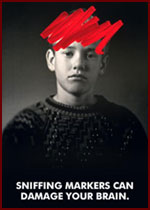Inhalants: The Deadly Dangers to Children and Adults of Accidental and Intentional Abuse
by SixWise.com
Common, seemingly harmless products in your home-cleaning solutions,
paint and glue products, air fresheners, even whipped cream cans-are known
to the Office of National Drug Control Policy and other drug agencies
as inhalants. That's because when inhaled by sniffing or huffing (through
the mouth) the volatile chemicals they contain cause psychoactive, mind-altering
and health-damaging effects.
About 23 million Americans aged 12 and over have used inhalants at least
once in their lives, according to the 2003 National Survey on Drug Use
and Health. That's 9.7 percent of the total population in that age group.
And use typically starts early-sometimes as young as elementary school
age-with one in five eighth graders saying they've used inhalants, according
to the National Institute on Drug Abuse (NIDA).
|

Posters like this one from the National Institute on Drug Abuse
are trying to bring national attention to the dangers of inhalant
abuse.
|
And the problem seems to be increasing. While drug use in other categories
went down, the Department of Health and Human Services'
2004 Monitoring the Future (MTF) survey found that lifetime inhalant use
for eighth graders increased significantly.
Said Dr. Nora D. Volkow, NIDA director, "We are concerned about
the increasing number of eighth graders using inhalants. Research has
found that even a single session of repeated inhalant abuse can disrupt
heart rhythms and cause death from cardiac arrest or lower oxygen levels
enough to cause suffocation. Regular abuse of these substances can result
in serious harm to vital organs including the brain, heart, kidneys, and
liver."
According to the survey, 17.3 percent of eighth graders, 12.4 percent
of tenth graders, and 10.9 percent of twelfth graders said they'd used
inhalants at least once during their lifetimes!
Why, and How, do People Use Inhalants?
When inhaled, these products have at first a stimulating effect and then
make the user feel less inhibited and less in control. A user can also
lose consciousness. Inhalants can be sniffed or sprayed directly into
the nose or mouth, but also by:
- Bagging: Sniffing or inhaling fumes that have been sprayed
inside a paper or plastic bag
- Huffing: Absorbing fumes from an inhalant-soaked rag that's
stuffed in the mouth
- Inhaling gas such as helium or nitrous oxide from a balloon
What Kinds of Health Dangers are Involved?
Though inhalants receive little attention when compared to other recreational
drugs, their health effects are no less dangerous.
Short-term effects of inhalants include mood swings, violent behavior,
headaches, abdominal pain, muscle weakness, tingling and numbness in the
hands and feet, hearing loss, fatigue, lack of coordination and nausea.
But there are long-term effects as well-abusing inhalants can result
in heart failure and death even after one use, a condition known as Sudden
Sniffing Death Syndrome (SSDS). According to the Dekalb County Sheriff's
Department:
"Sudden Sniffing Death Syndrome is the most common killer of inhalant
abusers. A victim may be trying inhalants for the first time, or may have
tried them any number of times in the past. In fact, 22 percent of inhalant
abusers who died of SSDS had no history of previous inhalant abuse. SSDS
occurs when an abuser is surprised or startled while sniffing or huffing.
Often, this occurs when a parent or authority figure finds the person
inhaling. An especially exciting or frightening hallucination could also
trigger SSDS."
Also, when high concentrations of these products are inhaled, they displace
oxygen from the lungs and central nervous system. Breathing stops and
the user actually suffocates. As such, brain damage and central nervous
system damage can also occur, along with damage to the liver, heart, bone
marrow and kidneys. Limb spasms and blood oxygen depletion are other,
sometimes permanent, effects.
Although inhalants are most dangerous when intentionally inhaled, breathing
fumes while cleaning http://www.sixwise.com/newsletters/newsletters.html
and using glues, paints and other chemical products can also produce some
of the short- and long-term health effects mentioned above. That's why
you should always be sure to use such products in a well-ventilated area,
or seek out natural alternatives that don't pose the same health risks.
 Signs
of Inhalant Abuse Signs
of Inhalant Abuse
Since inhalants are common, household products, it can be hard
to notice when they're being abused. Here are some signs that a
person may be using them destructively (the boy in this picture
had been huffing green spray paint):
-
Depression
-
Drunk or dazed behavior
-
Excessive irritability or restlessness
-
Chemical odor on breath or clothing
-
Paint stains on fingers or face
-
Nosebleeds
-
Red, runny eyes
- Hiding objects like correction fluid, aerosol cans, hairspray
|
Common Household Inhalants
- Glue, rubber cement
- Spray paint
- Hair spray
- Air Freshener
- Deodorant
- Fabric sprays
- Nail polish remover
- Paint thinner
- Type correction fluid
- Markers
- Lighter fluid
- Spot remover
- Degreaser
- Dry cleaning fluid
- Vegetable cooking spray
- Whipped cream aerosols
- Helium
- Propane
- Nitrous oxide
- Gasoline
- Household cleaners
- Air conditioning coolants (Freon)
|
If Someone You Know is Abusing Inhalants ...
Inhalants are physically and psychologically additive and once a person
stops using them they will suffer withdrawal symptoms. If you suspect
someone you love is abusing inhalants, seek professional help, such as
contacting a school nurse, social worker or counselor, immediately. Some
resources to contact include:
Recommended Reading
Ecstasy:
How Dangerous is This Wildly Popular Drug?
Joining
a Gang: How to Help Kids Prevent it,
How to Tell if They've Joined One, How to Help Them Out
Sources
Office
of National Drug Control Policy
National
Inhalant Prevention Coalition
National
Institute on Drug Abuse
Inhalant
Abuse: It's Deadly
Health
Hazards Associated With Inhalant Abuse